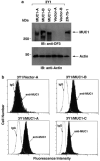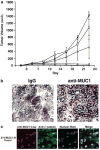Human DF3/MUC1 carcinoma-associated protein functions as an oncogene
- PMID: 12955090
- PMCID: PMC4209839
- DOI: 10.1038/sj.onc.1206732
Human DF3/MUC1 carcinoma-associated protein functions as an oncogene
Abstract
The human DF3/MUC1 mucin-like glycoprotein is aberrantly overexpressed by most carcinomas of the breast and other epithelia. The contribution of MUC1 overexpression to the malignant phenotype is, however, not known. In the present studies, we have stably expressed MUC1 in rat 3Y1 fibroblasts. MUC1-positive cells were selected from independent transfections. The results demonstrate that, as found in human carcinomas, MUC1 is expressed on the cell surface and as a complex with beta-catenin in the nucleus of the transfectants. Colony formation in soft agar demonstrates that cells expressing MUC1, but not the empty vector, exhibit anchorage-independent growth. The results also show that MUC1 expression confers tumor formation in nude mice. These findings provide the first evidence that MUC1 induces cellular transformation.
Conflict of interest statement
DK has a financial interest in ILEX.
Figures




References
-
- Bromberg JF, Wrzeszczynska MH, Devgan G, Zhao Y, Pestell RG, Albanese C, Darnell JE., Jr Cell. 1999;98:295–303. - PubMed
-
- Gendler S, Taylor-Papadimitriou J, Duhig T, Rothbard J, Burchell JA. J Biol Chem. 1988;263:12820–12823. - PubMed
-
- Guilford P, Hopkins J, Harraway J, McLeod M, McLeod N, Harawira P, Taite H, Scoular R, Miller A, Reeve AE. Nature. 1998;392:402–405. - PubMed
-
- Jemal A, Murray T, Samuels A, Ghafoor A, Ward E, Thun M. CA Cancer J Clin. 2003;53:5–26. - PubMed
-
- Kintner C. Cell. 1992;69:225–236. - PubMed
Publication types
MeSH terms
Substances
Grants and funding
LinkOut - more resources
Full Text Sources
Other Literature Sources
Research Materials
Miscellaneous

